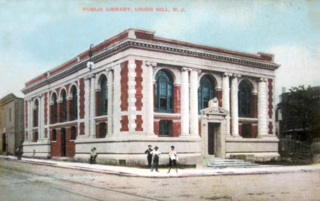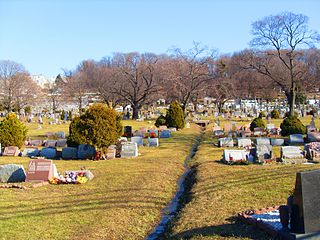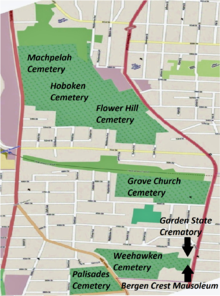
North Bergen is a township in the northern part of Hudson County, in the U.S. state of New Jersey. As of the 2020 United States census, the township's population was 63,361, an increase of 2,588 (+4.3%) from the 2010 census count of 60,773, which in turn reflected an increase of 2,681 (+4.6%) from the 58,092 counted in the 2000 census. The township was incorporated in 1843. It was much diminished in territory by a series of secessions. Situated on the Hudson Palisades, it is one of the hilliest municipalities in the United States. Like neighboring North Hudson communities, North Bergen is among those places in the nation with the highest population density and a majority Hispanic population.

Union City is a city in the northern part of Hudson County, in the U.S. state of New Jersey. As of the 2020 United States census, the city was the state's 18th-most-populous municipality, with a population of 68,589, an increase of 2,134 (+3.2%) from the 2010 census count of 66,455, which in turn had reflected a decline of 633 (−0.9%) from the 67,088 counted in the 2000 census. As of the 2010 Census, among cities with a population of more than 50,000, it was the most densely populated city in the United States, with a density of 54,138 per square mile of land. The Census Bureau's Population Estimates Program calculated that the city's population was 65,366 in 2022, ranking the city the 590th-most-populous in the country.

Flower Hill Cemetery is located in North Bergen, New Jersey. It is cojoined with Hoboken Cemetery and Machpelah Cemetery.

Bergenline Avenue is a station on the Hudson–Bergen Light Rail (HBLR). The intermodal facility is located on 49th Street between Bergenline Avenue and Kennedy Boulevard in Union City, New Jersey, near its border with West New York and North Bergen. The station is the first and only completely underground station on the network and opened for service on February 25, 2006.

The Hackensack Plank Road, also known as Bergen Turnpike, was a major artery which connected the cities of Hoboken and Hackensack, New Jersey. Like its cousin routes, the Newark Plank Road and Paterson Plank Road, it travelled over Bergen Hill and across the Hackensack Meadows from the Hudson River waterfront to the city for which it was named. It was originally built as a colonial turnpike road as Hackensack and Hoboken Turnpike. The route mostly still exists today, though some segments are now called the Bergen Turnpike. It was during the 19th century that plank roads were developed, often by private companies which charged a toll. As the name suggests, wooden boards were laid on a roadbed in order to prevent horse-drawn carriages and wagons from sinking into softer ground on the portions of the road that passed through wetlands. The company that built the road received its charter on November 30, 1802. The road followed the route road from Hackensack to Communipaw that was described in 1679 as a "fine broad wagon-road."

Bergenline Avenue is a major commercial district in the North Hudson section of Hudson County, New Jersey, United States. The north–south streets passes through Union City, West New York, Guttenberg, and North Bergen. Its southern end is at Union City's Second Street, the north boundary of Washington Park. From there north to 47th Street, the street is one-way southbound; New York Avenue and Kennedy Boulevard serve northbound traffic. Between 48th and 49th Streets, elevators on the west side provide access to the underground Bergenline Avenue station of the Hudson-Bergen Light Rail. After passing through West New York and Guttenberg and into North Bergen, the street meets North Hudson Park, running along its west side from 79th Street to the Bergen County line through the community of Nungesser's and crosses Kennedy Boulevard. The northernmost 0.04 miles (0.064 km) of the route from Kennedy Boulevard to the Bergen County line is designated as County Route 721. North of the county line the street name becomes Anderson Avenue, which is the major commercial district for Fairview, Cliffside Park, and Fort Lee.

Union Hill was a town that existed in Hudson County, New Jersey, United States, from 1864 to June 1, 1925, when it merged with West Hoboken to form Union City.

The Old Bergen Church is a historic church congregation in Jersey City, Hudson County, New Jersey, United States. Established in 1660 in what was then the Dutch colony of New Netherland, it is the oldest continuous religious congregation in what is today the State of New Jersey. The congregation is jointly affiliated with the Reformed Church in America and the Presbyterian Church (USA). The church was added to the National Register of Historic Places on August 14, 1973. The original church building was constructed in 1680 and the current edifice was built in 1841.

The Weehawken Cemetery, like neighboring Hoboken Cemetery, is not located in its namesake town of Weehawken but rather on the western slope of the Hudson Palisades in North Bergen, New Jersey, with its main entrance on Bergen Turnpike. At its east side the cemetery is overlooked by the Bergen Crest Mausoleum and the Garden State Crematory. and nearby Flower Hill Cemetery.

Schuetzen Park is a privately owned park in North Bergen, New Jersey, United States, that has existed since 1872 and is located on the ridge of the Hudson Palisades at Kennedy Boulevard and Bergen Turnpike just north of the Marginal Highway. Its southern and western perimeters are shared with the Fritz Reuter Altenheim, a retirement community named for the German author, Fritz Reuter, and Columbia Park, a large shopping center. The German-American Volksfest has taken place there annually since its construction.

New Durham is a neighborhood in North Bergen Township in Hudson County, in the U.S. state of New Jersey. It is located near the foot of Union Turnpike and Bergen Turnpike, and south of the Tonnelle Avenue Station of the Hudson Bergen Light Rail. It is one of the few residential areas along the otherwise industrial/commercial Tonnelle Ave, and site of one of the town's main post offices.

Bergenwood is a long narrow district of North Bergen, New Jersey in the northern central part of the township between Kennedy Boulevard and Tonnelle Avenue, characterized by the steep slopes on the west side of the Hudson Palisades as they descend to the New Jersey Meadowlands.

County Route 617 is 4.55-mile (7.32 km) long and follows one street, Summit Avenue along the ridge of the Hudson Palisades in Hudson County, New Jersey. Its southern end is CR 622, or Grand Street, at Communipaw Junction in the Bergen-Lafayette Section of Jersey City. Its northern end is CR 691, 32nd Street, a section of the Bergen Turnpike, in Union City.

Central Avenue is a 12-block-long thoroughfare in the Heights neighborhood of Jersey City, New Jersey, United States. One of 13 shopping districts in the city, it is designated County Route 663 for 1.60-mile (2.57 km) of its length. It originates at the intersection of Summit Avenue and Pavonia Avenue, and runs north, intersecting Newark Avenue one block east of Five Corners to Paterson Plank Road near Transfer Station. The avenue continues north through Union City without the county route designation to 35th Street, two blocks north of Hackensack Plank Road.

Nungessers is the name of the confluence of roads that meet at the Hudson and Bergen county line at North Bergen and Fairview in northeastern New Jersey. The area is the former site of the Nungesser's Gutenberg Racetrack, a late 19th-century gaming and gambling venue. The neighborhood just south of Nungesser's is called the Racetrack Section and the municipality of Guttenberg is nearby. A White Castle, an early drive-in fast-food chain, originally built in the 1930s has long been a landmark in the neighborhood, as has adjacent North Hudson Park.

The Machpelah Cemetery, also spelled as "Macpelah Cemetery", or "Macphelah Cemetery", is a cemetery in Hudson County, New Jersey.

Bergen Crest Mausoleum is a mausoleum in Hudson County, New Jersey.

The Abel I. Smith Burial Ground was a family burial plot in Hudson County, New Jersey, United States.






















